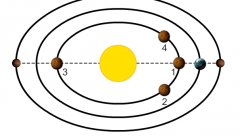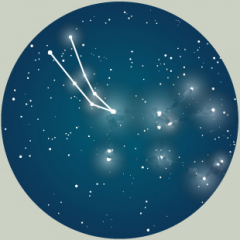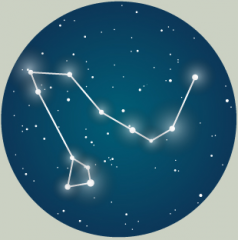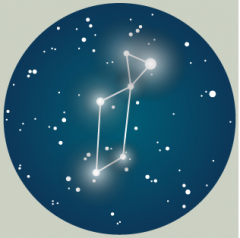![]()
![]()
![]()
Use LEFT and RIGHT arrow keys to navigate between flashcards;
Use UP and DOWN arrow keys to flip the card;
H to show hint;
A reads text to speech;
27 Cards in this Set
- Front
- Back
- 3rd side (hint)
|
Where on the Earth do the suns rays hit most directly when it is the autumnal equinox in the Northern Hemisphere?
|
The Equator.
|
|
|
|
A planet has a rotation period of three hours. Which planet type is it most likely to be?
|
Jovian
|
|
|

What is position 3 called?
|
Superior conjunction.
|
|
|

What is the constellation?
|
Andromeda.
|
|
|
|
What is the most convenient unit for comparing distances within the solar system?
|
Astronomical Units (AU)
|
|
|
|
Which of the following characteristics would indicate a planet is Jovian?
A. many satellites B. small size C. rocky surface D. high temperature |
A. Many satellites
|
|
|
|
Who invented the reflecting telescope?
|
Isaac Newton
|
|
|
|
Which astronomer tried to prove a heliocentric universe was wrong?
|
Tycho Brahe
|
|
|
|
What is the name of the bright star in Canis Minor?
|
Procyon
|
|
|
|
Which of the following properties is the most important to look for in an optical telescope?
A. refraction B. lens diameter C. magnification D. focal length |
B. Lens Diameter
|
|
|
|
Which of the following inventions collects astronomical information other than visible light?
A. radio telescope B. charge–coupled device C. cameras D. refracting telescope |
A. Radio Telescope
|
|
|
|
When does the vernal equinox occur in the Northern Hemisphere?
|
March 21st.
|
|
|
|
Which of the following electromagnetic waves has the lowest frequency?
A. visible light B. ultraviolet C. gamma rays D. infrared |
D. Infrared
|
|
|
|
Who invented the idea of epicycles to explain the observed motion of planets?
|
Ptolemy
|
|
|
|
How big is a parsec?
|
3.26 light–years
|
|
|
|
What could the time measured from a full moon to the next full moon be called?
|
synodic period
|
|
|
|
Who first proposed that the planets revolved around the sun?
|
Aristarchus
|
|
|
|
Which of the following correctly lists planets in order from the Sun outward? (Not all planets are listed)
A. Mercury, Earth, Jupiter, Mars, Neptune B. Mercury, Venus, Mars, Neptune, Saturn C. Mercury, Earth, Jupiter, Saturn, Uranus D. Mercury, Venus, Mars, Earth, Uranus |
C. Mercury, Earth, Jupiter, Saturn, Uranus
|
|
|
|
What is a photon?
|
a tiny packet of energy.
|
|
|
|
Which period can be readily observed?
|
synodic period
|
|
|
|
What is the darkest part of a planets shadow called?
|
Umbra
|
|
|
|
What is the name for the planetary configuration when Jupiter, Earth, and Sun are in a line with the Earth in between Jupiter and the Sun?
|
Opposition
|
|
|

What is the name of this constellation?
|
Draco
|
|
|
|
Which astronomer was the first to use a telescope to study the night sky?
|
Galileo Galilei
|
|
|
|
Astronomers used to use film cameras along with telescopes to study the night sky. Which of the following devices replaced the traditional film camera as a tool to record what telescopes can see?
A. concave mirror B. charge–coupled device C. microphone D. eyepiece |
B. Charge–coupled device
|
|
|
|
Which terrestrial planet is the smallest?
|
Mercury
|
|
|

What is the name of the bright star in this constellation?
|
Vega.
|
Constellation: Lyra |

